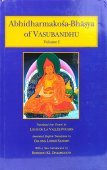Abhidhammapitaka, Abhidhamma-pitaka: 4 definitions
Introduction:
Abhidhammapitaka means something in Buddhism, Pali. If you want to know the exact meaning, history, etymology or English translation of this term then check out the descriptions on this page. Add your comment or reference to a book if you want to contribute to this summary article.
In Buddhism
Theravada (major branch of Buddhism)
Source: Pali Kanon: Pali Proper NamesThe third division of the Pitakas. It consists of seven books: the
Dhammasangani,
Vibhanga,
Kathavatthu,
Puggalapannati,
Dhatukatha,
Yamaka and
Patthana,
all designated by the name of Pakarana. Only in the Chronicles and the Commentaries is the word used as the title of a third Pitaka (See the discussion of this in DA.i.15, 18f). In the Canon itself (E.g., Vin.i.64; iii.144; iv.344) the word means special dhamma, i.e. the Doctrine pure and simple (without admixture of literary treatment or personalities, etc.), and is sometimes coupled with the word abhivinaya (E.g., D.iii.267; M.i.272).
It has been suggested (New Pali Dict. s.v.) that, as the word abhidhamma standing alone is not found either in the Sutta Nipata, the Samyutta, or the Anguttara, and only once or twice in the Digha and Majjhima, it probably came into use only towards the end of the period in which the four great Nikayas grew up (See Dial.iii.199 on a possible origin of the Adhidhamma).
The Mahasanghikas refused to include the Abhidhamma in the Pitakas at all, as they did not regard it as the word of the Buddha. (Dpv.v.32-8).
According to the Dighabhanakas the Abhidhamma Pitaka also included the whole of the Khuddaka Nikaya except the Cariyapitaka, Apadana and Buddhavamsa (DA.i.15).
According to another division, the five Nikayas are not divisions of the Dhamma but of the whole Canon, and in the fifth are included both the Vinaya and the Abhidhamma (DA.i.28).
There is a legend recorded by Buddhaghosa that the Abhidhamma was first preached by the Buddha in Tavatimsa at the foot of the Paricchataka tree, when he was seated on Sakkas throne, during his visit to his mother in Tavatimsa. Later it was taught by him to Sariputta on the banks of the Anotatta Lake, whither Sariputta had gone to minister to the Buddha during the latters visit to Tavatimsa (VibhA. p.1; AA.i.71, etc.).
The legend further relates that after the Enlightenment the Buddha spent the fourth week in the Ratanaghara, revolving in his mind the intricate doctrines of the Abhidhamma in all their details (J.i.78).
According to the Cullavagga version of the Councils (Chaps. xi. and xii; but see DA.i.15 contra) the Abhidhamma Pitaka was not rehearsed at either Council.
The fact that the Abhidhamma is not mentioned in the suttas and that only Dhamma and Vinaya are usually referred to, only proves that at one time the Abhidhamma did not form a separate Pitaka. As a matter of fact, it is not held even by the commentators to be the word of the Buddha in the same sense as the suttas. One section of it, the Kathavatthu (but see Kathavatthu), was taught only at the Third Council.
As far as we know, the seven books of the Abhidhamma are peculiar to the Theravadins,
Source: Dhamma Study: Introduction to the DhammaThird section of the Pali Canon.
The Abhidhamma Pitaka consists of seven books. These books are named as follows:-
- The Dhammasangani – the enumeration of all mental and material phenomena.
- The Vibhanga – the book of treatises of all phenomena.
- The Dhatukatha- the discussion of the groups, bases and elements of existence.
- The Puggalapannatti- the description of individual types of persons.
- The Kathavatthu- the discussion of points of controversy with schismatic sects.
- The Yamaka- the book of pairs of questions.
- The Patthana- the book of origination, conditionality and dependence of all the phenomena of existence (this is the largest and the most important Abhidhamma work).
See Abhidhamma.
Theravāda is a major branch of Buddhism having the the Pali canon (tipitaka) as their canonical literature, which includes the vinaya-pitaka (monastic rules), the sutta-pitaka (Buddhist sermons) and the abhidhamma-pitaka (philosophy and psychology).
General definition (in Buddhism)
Source: Buddhism Tourism: Glossary of Buddhist TermsThe third amongst the Buddhist cannon scriptures (other two been the vinaya and sutta), Abhidharma Pitaka presents the philosophical and psychological teachings of the early Buddhism.
See also (Relevant definitions)
Partial matches: Pitaka, Abhidhamma.
Full-text (+21): Tipitaka, Paramatthapakasini, Veyyakarana, Ti Pitaka, Canndavajji, Vijayawada, Atthasalini, Mulatika, Ratanaghara Cetiya, Abhidhamma, Mula, Vibhangappakarana, Pancappakarana, Dhatukatha, Khuddakanikaya, Dighabhanaka, Buddhadatta, Hadaya Vatthu, Patthanappakarana, Vibhajyavada.
Relevant text
Search found 29 books and stories containing Abhidhammapitaka, Abhidhamma-pitaka; (plurals include: Abhidhammapitakas, pitakas). You can also click to the full overview containing English textual excerpts. Below are direct links for the most relevant articles:
A Manual of Abhidhamma (by Nārada Thera)
Introductory Verse < [Chapter I - Different Types of Consciousness]
Subject - Matter < [Chapter I - Different Types of Consciousness]
Introducing Buddhist Abhidhamma (by Kyaw Min, U)
Appendix III - The Abhidhamma < [Book III]
Chapter 1 - Preliminaries < [Part 1 - Abhidhamma]
Part II - The Date Of The Manual < [Introductory Essay]
Part VI - On The Inquiry Into Rupam (form) < [Introductory Essay]
Guide to Tipitaka (by U Ko Lay)
(b) The Seven Books Of Abhidhamma < [Chapter IX - What Is Abhidhamma Pitaka?]
Chapter VIII - Khuddaka Nikaya
Part III - Dhatukatha Pali < [Chapter X - Abhidhamma Pitaka]
Buddhism in a Nutshell (by Narada Mahathera)
The Catu-Bhanavara-Pali (critical study) (by Moumita Dutta Banik)
Paritta as Bhavana Meditation < [Chapter 1 - Introduction]
Related products
